
In September 2025, an invasive beetle no bigger than a sunflower seed was discovered at the David Douglas Aquatic Center in Northeast Portland. For those who love Oaks Bottom Wildlife Refuge, this news marks the beginning of a profound transformation.
The emerald ash borer (EAB) has arrived in Portland, and with it comes the near-certain loss of every untreated Oregon ash tree in our refuge—trees that form the backbone of this treasured wetland ecosystem.
What Is the Emerald Ash Borer?
The emerald ash borer (Agrilus planipennis) is an iridescent green beetle native to northeastern Asia. First detected in the United States in Michigan in 2002, it has since killed more than 100 million ash trees across 37 states, making it the most destructive forest pest in North American history.
The damage isn’t caused by the adult beetles themselves, but by their larvae. Female beetles lay 60-90 eggs on ash bark, and when the eggs hatch, the tiny larvae tunnel beneath the bark into the tree’s cambium and phloem layers—the living tissue that transports water and nutrients throughout the tree. As they feed, they carve serpentine galleries that eventually girdle the tree, cutting off its lifeline. Within three to five years of infestation, even healthy ash trees die.
EAB was first discovered in Oregon in Forest Grove in June 2022, and forestry officials say Oregon should expect to lose 99% of its ash trees to this pest in time. Once a tree shows visible signs of decline—thinning canopy, yellowing leaves, D-shaped exit holes in the bark—it has likely been infested for several years. By then, multiple generations of beetles have already dispersed to nearby trees.


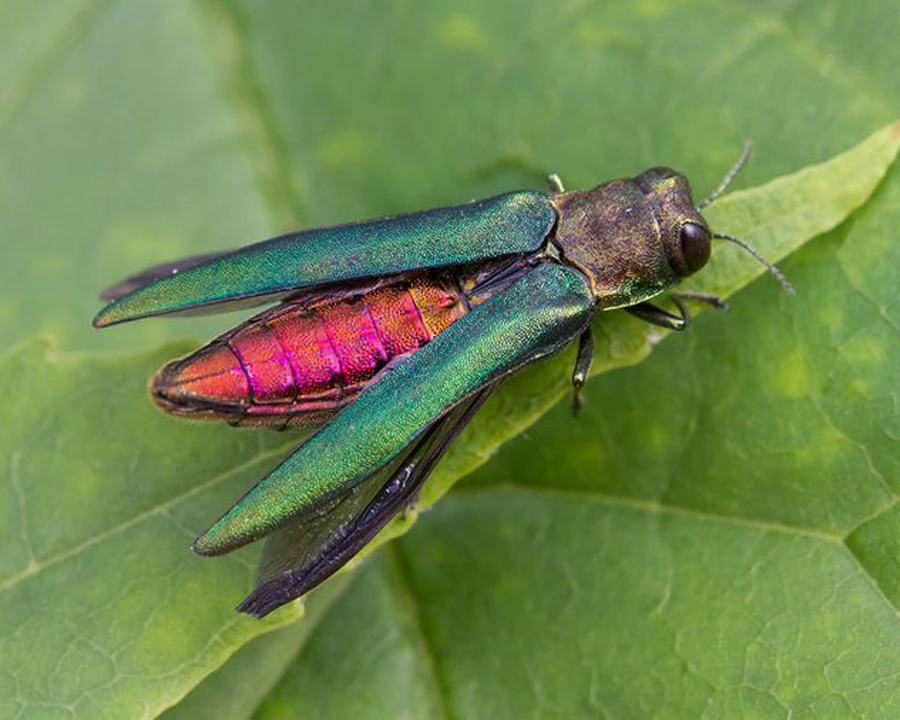
Why Oregon Ash Matters to Oaks Bottom
To understand what we stand to lose, we need to understand what Oregon ash (Fraxinus latifolia) provides.
Oregon ash is the only ash species native to the Pacific Northwest and the dominant tree in many of our region’s wetlands and riparian areas. In places like Oaks Bottom, where soils are heavy and saturated for months each year, Oregon ash thrives where few other native trees can.
A Keystone of Biodiversity
The ecological web supported by Oregon ash is staggering. These trees are habitat creators and food providers for an extraordinary array of species:
Direct consumers include deer and elk that browse leaves and twigs, while beaver and nutria eat bark and use the wood for shelter. Over 50 species of butterflies and moths use Oregon ash as a larval host plant, including the two-tailed swallowtail and Sympistis fortis, a moth that relies exclusively on Oregon ash. Lace bugs, aphids, plant bugs, webworms, and tree crickets all depend on these trees. In wetland areas, aquatic invertebrates feed on Oregon ash leaf litter and use it for shelter.
Seed eaters include finches and grosbeaks (especially evening grosbeaks, a species already in decline), along with rodents that consume fallen seeds.
Indirect beneficiaries encompass woodpeckers hunting for insects in the bark, songbirds and waterfowl using Oregon ash for shelter and nesting, and hawks and owls preying on the seed-eating rodents and birds the ash ecosystem supports.
And there’s more: Bees collect pollen from Oregon ash flowers. Bats roost in mature branches. Mosses, lichens, and ferns grow on the trees, creating microhabitats for countless invertebrates. Fungi colonize bark and leaves, providing additional food and habitat while contributing to nutrient cycling.
Critical Ecosystem Services
Beyond supporting wildlife, Oregon ash provides essential ecosystem services:
- Shade and temperature regulation: Ash canopy keeps streams and wetlands cool—crucial for native fish and amphibians as climate change warms our waterways
- Bank stabilization: Ash root systems prevent erosion along waterways and hold together the saturated soils of floodplains
- Water quality: Trees filter pollutants and slow stormwater runoff
- Flood mitigation: Wetland forests absorb and slow floodwaters, protecting downstream communities
As fish biologist Stan Gregory explained, in off-channel areas and along slower-moving streams where soils are heavy and poorly drained, ash is often the primary shade tree, sometimes comprising 95% of the canopy.
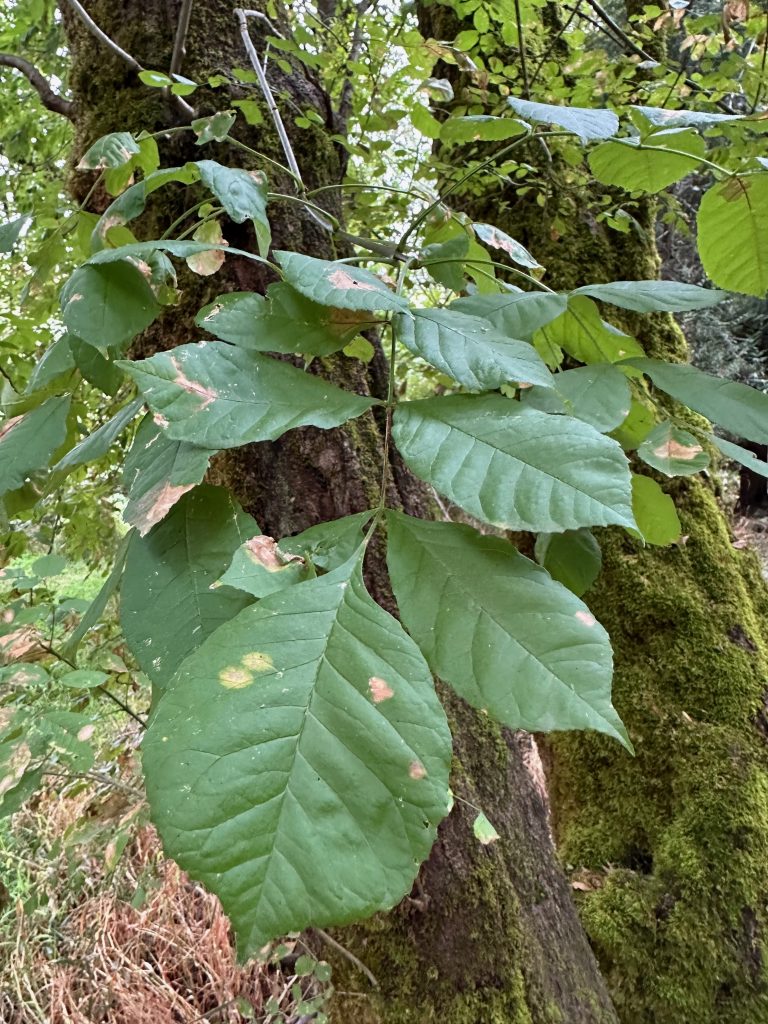
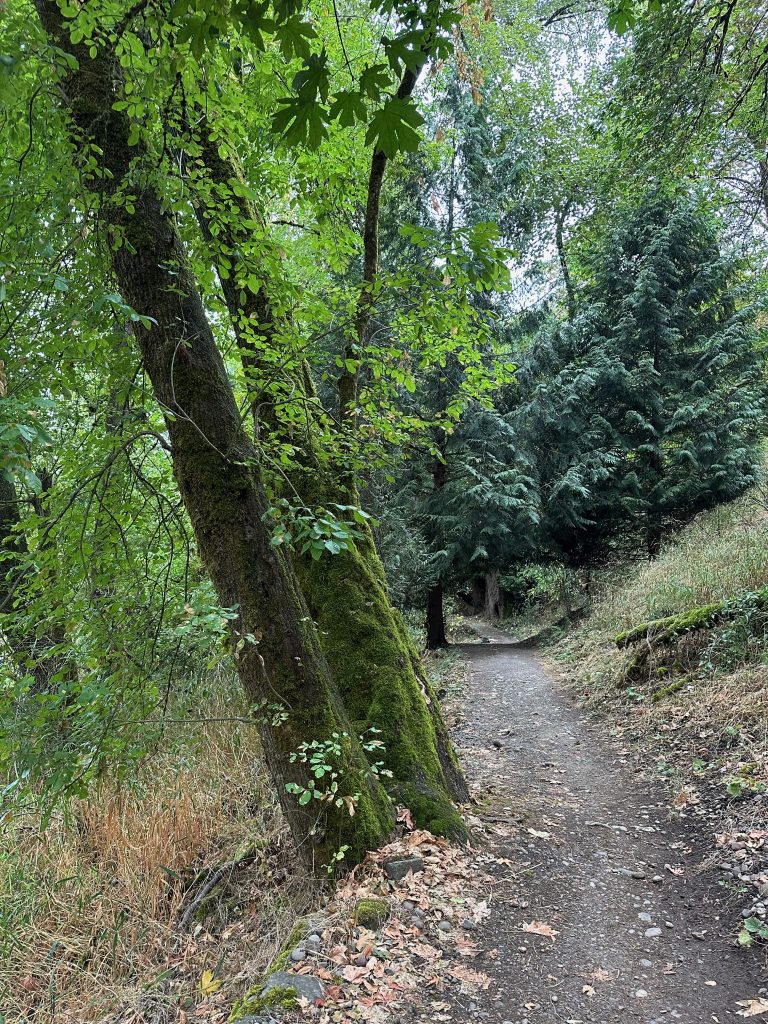
Oaks Bottom’s Ash Forest
According to Portland Parks & Recreation’s estimates, roughly 72% of Portland’s ash trees—approximately 68,000 trees—are located in natural areas. Oaks Bottom Wildlife Refuge, with its extensive wetlands and riparian corridors, contains substantial Oregon ash populations.
One of the most valuable assets of Oaks Bottom is its biodiversity: over 200 species of birds, 47 mammal species, 350 species of plants, at least 6 amphibians, and hundreds or thousands of insect species. Oregon ash is central to maintaining this richness.
With the loss of ash trees, the ecosystem will shift dramatically. Other trees may eventually fill the canopy gaps, but in the 5-20 years it takes for ash to die and new trees to mature, the refuge will face:
- Increased sunlight reaching the ground, potentially fueling invasive plant growth
- Loss of critical wildlife habitat and food sources
- Changes to wetland hydrology and water temperature
- Erosion along streams and ponds
- Altered flood patterns
What’s Being Done?
City and State Response
Portland Parks & Recreation released its Emerald Ash Borer Response Plan in June 2025, followed by a Natural Areas Addendum in October 2025. The plans outline a comprehensive strategy:
Monitoring: Portland has partnered with the Oregon Department of Forestry and USDA APHIS to place monitoring traps throughout the city, including at Oaks Bottom Wildlife Refuge. City staff and volunteers are being trained to identify and report EAB signs and symptoms.
Treatment: A limited number of high-value ash trees (those over 18 inches in diameter and in good health) will be treated with emamectin benzoate, an insecticide applied via trunk injection every two to three years. This treatment is expensive and labor-intensive, so it will be reserved for ecologically significant trees.
Removal and Replacement: Ash trees that pose safety risks near trails and public areas will be proactively removed over the next 10-15 years. The city plans to replace removed trees with diverse native species and implement “underplanting”—planting saplings beneath existing ash before they die to help fill canopy gaps more quickly.
Biological Control: Once EAB becomes established, the release of parasitic wasps that prey on EAB may help manage beetle populations in natural areas.
Seed Banking: The Oregon Department of Forestry has collected and stored nearly a million Oregon ash seeds from across the state. Researchers are growing these trees to identify any with natural EAB resistance, hoping to eventually restore resistant populations to the landscape.
A Monitoring Trap in Oaks Bottom
There is currently a purple prism trap installed at Oaks Bottom Wildlife Refuge as part of the city and state’s monitoring network. Traps are hung when adults are active, late May through September. These traps help track the spread of EAB and will remain in place until the refuge becomes heavily infested.
What You Can Do
While we cannot stop the spread of EAB, every action to slow it buys precious time for preparation and adaptation.
Don’t Move Firewood
Moving firewood is likely how EAB reached Oregon in the first place. Oregon forestry officials strongly advise against moving firewood or woody debris more than 10 miles from where you collect or purchase it. This simple action is one of the most effective ways individuals can slow the spread of invasive forest pests.
Learn to Identify Ash and EAB
Familiarize yourself with what Oregon ash looks like and learn to recognize signs of EAB infestation:
- Thinning or dead branches in the upper canopy
- Woodpecker activity (they love EAB larvae)
- Epicormic shoots (new sprouts growing from the trunk)
- Bark splits
If you see any of the above, then check for the following:
- D-shaped exit holes in the bark (about ¼ inch wide)
- Serpentine galleries under the bark or in bark splits
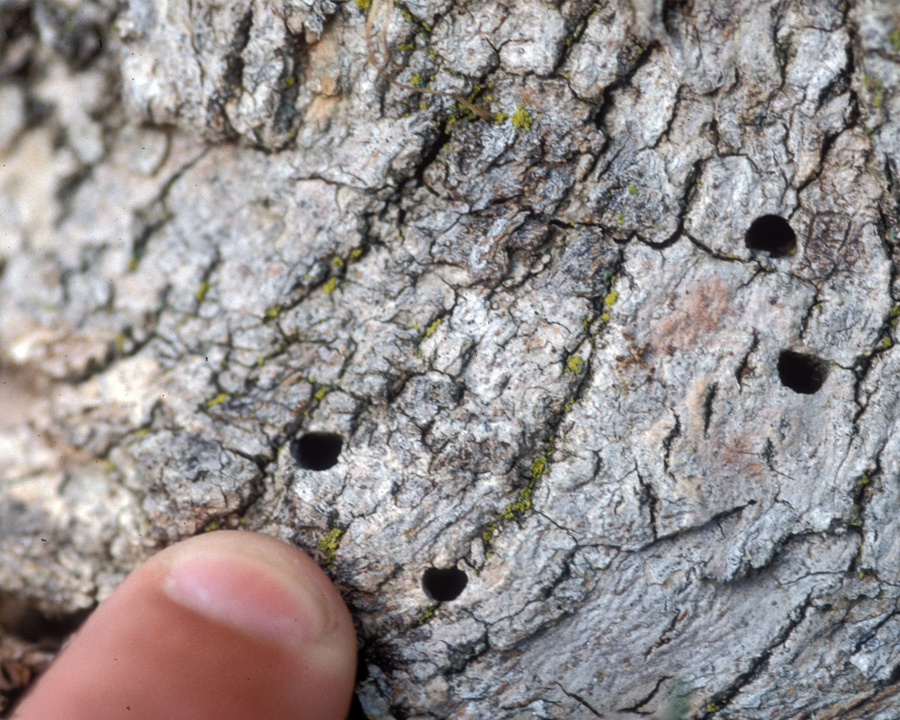
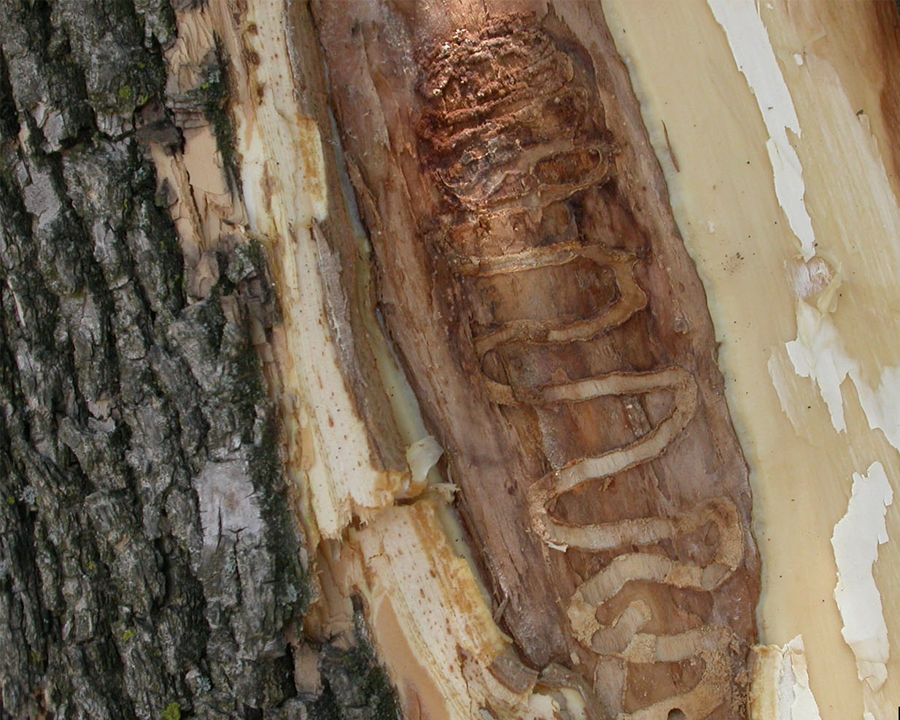
Report Suspected Infestations
If you observe signs of EAB, report them immediately to the Oregon Invasive Species Hotline: 1-866-INVADER (1-866-468-2337) or online at oregoninvasiveshotline.org.
Support Restoration Efforts
As ash trees decline, controlling invasive plants and planting native trees and shrubs will be critical to maintaining the ecological health of Oaks Bottom. Consider:
- Volunteering for restoration work parties with Friends of Oaks Bottom and other groups
- Supporting organizations working to restore urban natural areas
- Planting diverse native species in your own yard to support wildlife
Stay Informed
Follow updates from Friends of Oaks Bottom and Portland Parks & Recreation about EAB’s progression and management efforts at the refuge.
What to Expect
We will lose all of the ash trees in Oaks Bottom that aren’t treated—and treatment will be limited to a handful of the most ecologically significant specimens and those that pose a public safety hazard. This process may take 5-20 years, with the most rapid die-off expected to occur during peak infestation years.
The transformation will be dramatic. The refuge we know and love will change profoundly. But it won’t become a lifeless wasteland. Ecosystems are resilient and dynamic. New trees will grow. Wildlife will adapt. The question is not whether Oaks Bottom will endure, but what form it will take.
As one researcher noted, if we returned in 10,000 years, ash trees would be here again—they would eventually develop resistance through natural selection. But in our human timeframe, we face a transition period of loss and transformation.
This is not a crisis we can solve, but it is one we can navigate thoughtfully. By understanding what we’re losing, by managing this change as carefully as possible, and by being purposeful about how we help the ecosystem adapt, we can ensure that Oaks Bottom remains a vital haven for biodiversity for generations to come.
The ash may vanish, but the refuge endures—changed, yes, but still wild, still essential, still worth protecting.
Further Reading and Resources
- Portland’s Emerald Ash Borer Response Plan: portland.gov/trees/eab
- Oregon EAB Information Hub: OregonEAB.com
- High Country News: “Watching the Oregon Ash Vanish” – An excellent deep dive into the ecological and cultural significance of Oregon ash
- Oregon Invasive Species Hotline: 1-866-INVADER or oregoninvasiveshotline.org
- Oregon Field Guide Episode: Oregon’s ash trees are dying — Can anything stop the Emerald ash borer beetle?

